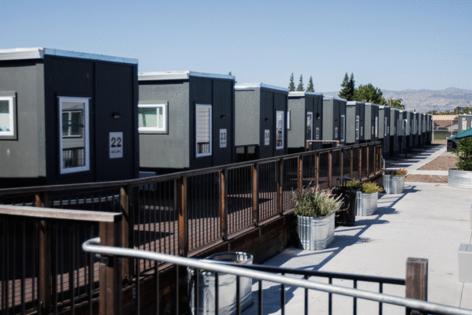One San Jose tiny home shelter is successfully moving people to housing. Can it be a model for other sites?
Published in Business News
San Jose, California, more than any other Bay Area city, has embraced tiny homes as a solution to homelessness.
Since 2020, the city has developed six tiny home sites with around 500 beds. Three upcoming locations will add more than 700 new beds. The facilities provide rent-free private units, some with individual bathrooms, as well as shared kitchens and even community gardens.
But people aren’t meant to stay forever. The goal is to help them move to permanent housing, generally in about six to nine months. As the city faces a severe affordable housing shortage, however, not everyone finds lasting homes.
According to city data, only about half of the roughly 1,380 residents who’ve moved through the “interim housing” sites over the past three-plus years have transitioned to permanent housing, and results varied widely between sites.
One tiny home site for families with children on Evans Lane in South San Jose is outperforming the rest, with nearly eight in 10 residents finding housing upon leaving. As San Jose pushes to build tiny homes to bring more of its estimated 4,400 unsheltered residents off the street, what can the city learn from Evans Lane?
Local officials attribute the site’s success to a collaboration between San Jose and Santa Clara County to offer services that create a clear pathway to housing. Unlike other tiny home shelters, Evans Lane residents have access to a countywide program that connects homeless families with federal housing vouchers, rental assistance and help finding low-income apartments.
“The reason why that site is doing better than others is because we have had more resources for families,” said Consuelo Hernandez, director of Santa Clara County’s Office of Supportive Housing, which oversees the program.
On a recent afternoon at Evans Lane, the squeals of children pushing scooters and skateboards along the path between the 48 boxy tiny homes pierced the whooshing hum of the neighboring Almaden Expressway. One resident sat at a picnic table in the community courtyard, recalling nights when she and her now teenage son and daughter were left with nowhere to go but the city’s parks.
“For me to see how comfortable they are now and how good they are resting — they shower, I make sure they do chores, it makes me feel good,” the woman said. “Because I know that they have nothing to worry about today.”
The family moved into Evans Lane about eight months ago after a stay at a sober living facility. Working with a case manager provided by the site’s nonprofit operator, the woman said she finally has enough stability and support to find a steady job and an affordable apartment.
From Evans Lane’s opening in 2021 through the beginning of May, 243 of the 316 residents who left the site found housing — the most of any of the city’s tiny home facilities. At three other sites, residents found housing between around 40% and 50% of the time. Another site had a meager 29% success rate.
At one East San Jose tiny home site, which restricts residents to six-month stays because it’s on state property with stay limits, only 51 of the 284 residents who left moved to lasting homes, about 18%. Other sites don’t have set time limits, though city officials said they are considering capping such stays.
Across all the facilities, around 300 people moved to other shelters, hospitals, jails or other temporary locations. Nearly 400 residents, close to 30%, returned to homelessness or unknown locations.
San Jose Mayor Matt Mahan said that in addition to pooling resources with the county, Evans Lane sees consistently better outcomes because it offers services tailored to a specific population, in this case, families, who are referred to the site through a nonprofit hotline. For example, site staff help families enroll children in school and coordinate transportation to class.
“Evans Lane is just an exceptional success story that we need to closely study and replicate in other places,” Mahan said.
Although many tiny home residents struggle to find housing, Mahan contends that interim solutions, including safe overnight parking lots, are still more welcoming alternatives to traditional group shelters with little privacy and generally have higher placement rates to housing. Even so, Mahan said he also wants the city to add more congregant shelters and start opening sanctioned encampment areas for homeless people cleared from city waterways.
Mahan also contends tiny homes are a relatively fast and cost-effective way to bring homeless people indoors, crediting the sites for an 11% drop in the city’s unsheltered population last year. After securing approval, tiny home sites can be constructed in six to eight months at a cost of about $65,000 a unit, he said. Building new affordable apartments, meanwhile, takes years and can cost $1 million each.
As San Jose and other cities — including Oakland, San Francisco, Sacramento and Los Angeles — increasingly turn to tiny homes amid mounting frustration over street homelessness, some homeless advocates contend shifting too many resources toward shelter options is a shortsighted strategy that will end up costly in the long run.
San Jose expects to spend $25 million next year on its portfolio of tiny homes. If it follows through on plans to add 784 more beds within the next 18 months, officials estimate the cost of operating the sites could balloon to $70 million by 2028. Facing a $50 million budget shortfall, the city is considering a controversial plan to divert either $8 million or $19 million from the city’s roughly $36 million in annual affordable housing development funds to help cover next year’s tiny home costs.
More funding challenges could lie ahead. At the state level, Gov. Gavin Newsom has proposed discontinuing $1 billion in annual homelessness grants sent to cities. And county officials say their supply of federal housing vouchers, after getting a boost during the pandemic, is now running low.
Jennifer Loving, CEO of the Silicon Valley homelessness solutions nonprofit Destination: Home, said that to solve the crisis, more permanent housing investment is needed by all levels of government.
“If we don’t focus on increasing the supply of housing that is actually affordable for people who need it,” she said, “there’s not enough tiny homes in all the land to deal with the onslaught of people who can’t afford the rent.”
©#YR@ MediaNews Group, Inc. Visit at mercurynews.com. Distributed by Tribune Content Agency, LLC.







Comments